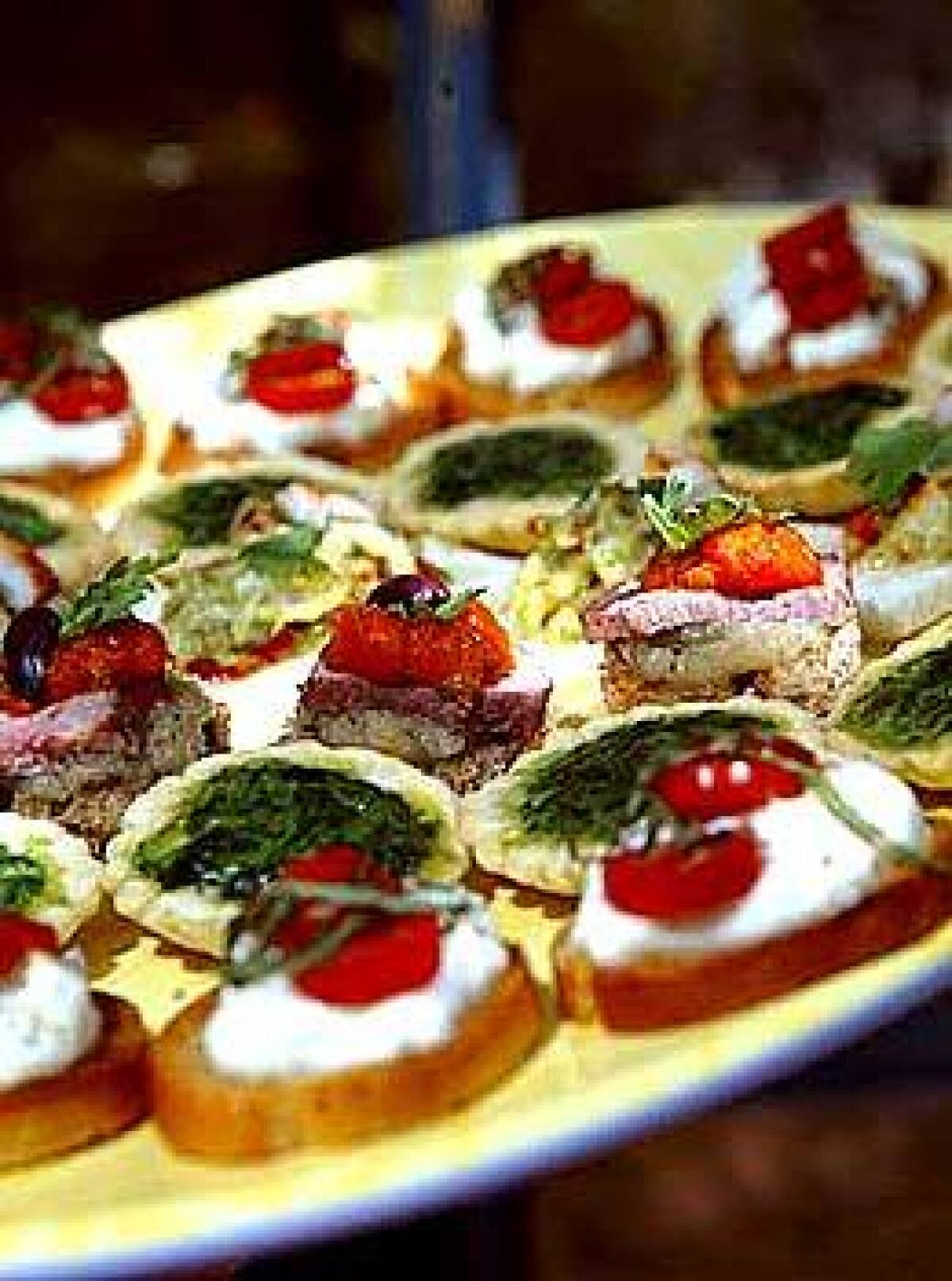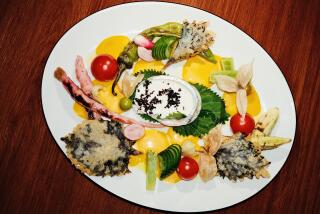The small, the good and the beautiful

Everyone loves canapés.
They’re beautiful, inviting, and terribly tasty. They make a great splash either as a prelude to dinner served with glasses of sparkling wine or as an event on their own with cocktails. Canapés set a tone, alerting guests that something special’s going on, that care has been taken. They’re not just for full-blown cocktail parties — try inviting a few friends for canapés and drinks before going out to dinner.
“A good canapé should incorporate in one bite everything that’s great about a fabulous meal,” says Eric Greenstein, chef-owner of Contemporary Catering in Los Angeles.
Canapés are bite-sized hors d’oeuvres made by assembling different ingredients on bread or a bread-like base (“canapé” is the French word for “couch”), though these days the definition can be stretched. The interplay of colors, textures and flavors is what makes a canapé attractive and intriguing, and a tray filled with them goes the small plate craze one better. We turned to some of the top caterers around town for a selection of this season’s best.
At Along Came Mary, passed hors d’oeuvres this summer include a number of canapés made with bases other than bread, says general manager Erick Weiss. Pita cups hold mini Greek salads, won ton cups are filled with Asian slaw, and roasted potato slices form the base of tuna niçoise stacks.
Mini caprese salads seem to be on every caterer’s pick list, but the ones made by chef Elka Gilmore of Gai Klass in Culver City are distinguished by the use of burrata cheese (instead of mozzarella) topped with tiny quarters of cherry tomatoes and slivers of fresh basil. Gilmore serves hers on cracked-pepper shortbread, but we’ve opted for easy slices of toasted baguette.
“A lot of time when I’m thinking about hors d’oeuvres, I’m thinking about shrinking something,” says Gilmore, who also makes a canapé with roasted lamb, sweet shallot confit and oven-dried tomato jam that was inspired by an entrée she created. She serves it on toasted olive bread, but, she says, “we’ve done it on roasted zucchini. I’ve done it with roasted garlic instead of shallots. I’ve done it with reduced balsamic instead of the tomatoes.”
The layering of flavors is the essence of canapé craft. Various elements — cooked meat or seafood, confits or purées, fresh vegetables, herb garnishes — are prepared separately, then arranged on a base. Keep canapés bite-sized, but don’t get too precious about shapes or too fussy with garnishes: This is L.A., not Stepford.
Contemporary Catering’s Greenstein has an inventive list, including lemon-poached shrimp with green-olive spread on toasts. Greenstein revived a cunning ‘50s technique for preparing the toasts: He removes the crusts from slices of white sandwich bread, then flattens the bread with a rolling pin, cuts it into squares or shapes, and bakes it until golden. Shrimp are poached in water, lemon juice and brown sugar, then dressed with olive oil, lemon juice and zest, sugar, salt and pepper. He makes his green-olive spread, but any tapenade could be used. Assembly is straightforward: a toast, a dollop of tapenade and a shrimp.
Indeed, Greenstein recommends that people who entertain a lot keep jars of tapenade, roasted red peppers, cornichons, good-quality imported tuna and anchovies and the like on hand so they can throw together canapés at the last minute.
“If you’re doing a cocktail-esque party, where you’re not serving a meal, canapés are great,” says Alexandra Angle. “They’re light, so they’re great in summer. A lot can be done in advance — it’s mostly assembly that’s required just before the party.”
She and her husband, Eliot, are not only caterers, they also have written “Cocktail Parties With a Twist” and the upcoming “Perfect Summer Parties With a Twist.” Some of their favorite canapés this season are spinach and sweet miso tartlets; eggplant caviar on garlic toast rounds; minted shrimp on pea and sorrel purée canapés; roasted cherry tomatoes with ricotta and sage; and jicama slices with avocado and crab salad. Jicama is not only crunchy, it has a lightly sweet taste that works with a wide range of flavors.
The Angles’ miso-spinach tartlets pair buttery pastries (which can be made ahead) with a savory spinach filling enlivened with miso and mirin. The same pastry shells can be filled with any number of things, says Angle. “There are a zillion ways you can do a tartlet. We do tofu or teriyaki, or Mexican flavors, or simple ham and cheese.”
Assemble your canapés on baking sheets so you can store them easily (wrapped with plastic film), and transfer them to platters and trays just before serving.
Gilmore suggests modern glass slabs for a contemporary look, or “ethnically appropriate” serving dishes such as Italian pottery for the mini caprese salads. The Angles often line trays with leaves (grape or banana work well) or rose petals.
Then pass the tray, sit back and enjoy the rest of the summer.
*
Spinach and sweet miso tartlets
Total time: 1 hour, plus 2 hours chilling
Servings: Makes about 3 dozen (2-inch) tartlets
Note: From Alexandra and Eliot Angle. You will need 2-inch tartlet molds.
Tartlet shells
2 1/2 cups flour
1 teaspoon salt
16 tablespoons sweet butter, cut into small pieces
1/2cup ice water
1. Combine the flour, salt and butter in a food processor and pulse until a crumbly dough forms. Add the ice water to the dough and continue pulsing until well mixed. Form the dough into a ball, wrap securely in plastic wrap and refrigerate until firm, about 2 hours. (At this point the dough can be placed in a sealed plastic bag and frozen for up to one month. To use, place in the refrigerator for 2 hours to thaw before baking.)
2. Heat the oven to 400 degrees. Take half the dough from the refrigerator, transfer it to a flat, floured surface and roll it out to a one-eighth-inch thickness. With a small glass or a cookie cutter, cut circles that are slightly larger than the 2-inch tartlet molds. Press each circle into a mold and pinch off any excess. Pierce the bottom and sides of each shell several times with a fork and put them in the freezer for 10 minutes to re-chill the dough.
3. When the dough is firm again, bake the shells for 15 to 16 minutes, until they are very light golden. Cool on wire racks before carefully turning out of the molds.
4. Repeat the rolling out, molding and baking process with the remaining dough. At this point the shells are ready to be filled or they may be transferred to an airtight container and refrigerated for up to 1 week or frozen for up to 1 month.
Filling and assembly
8 ounces baby spinach, blanched
3 tablespoons sweet white miso
2 teaspoons mirin
1 1/2 tablespoons rice vinegar
3/4 teaspoon salt
3/4teaspoon sugar
1 1/2 tablespoons water
2 large eggs, beaten
1/3cup heavy cream
1. Squeeze excess water from the spinach, then chop finely or purée; set aside.
2. In a saucepan over low heat, whisk together the miso, mirin, vinegar, salt, sugar and water until a smooth sauce forms. Remove the mixture from the heat, add the spinach and toss to combine. Stir in the eggs and cream.
3. Reduce the oven heat to 350 degrees. Spoon a scant 1 tablespoon of filling into each shell. Transfer the filled shells to a baking sheet, cover gently with foil and bake for 15 minutes or until the mixture has set. Remove the foil, bake for 2 minutes longer, then serve.
Each tartlet: 55 calories; 1 gram protein; 4 grams carbohydrates; 0 fiber; 4 grams fat; 2 grams saturated fat; 22 mg. cholesterol; 130 mg. sodium.
*Roasted lamb canapés
Total time: 1 hour, 15 minutes
Servings: 24 canapes
Note: From Elka Gilmore of Gai Klass. The chef uses one (12-ounce) boneless lamb loin roasted with olive oil, salt and pepper until medium-rare.
Shallot confit
1/2 pound whole peeled shallots
2 tablespoons sugar
2 teaspoons herbes de Provence
4 tablespoons extra virgin olive oil
1. Heat the oven to 375 degrees. Place the shallots on a large piece of foil. Add the sugar, herbes de Provence and olive oil and fold the foil, sealing the edges to make a packet. Bake for 45 minutes or until soft.
2. Remove the shallots, discarding the oil in the foil. Puree the shallots in a food processor until smooth. Makes three-fourths cup.
Tomato jam
1 tablespoon olive oil
1 tablespoon chopped shallot
1 cup peeled, seeded and finely diced tomato (about 2 medium)
1 teaspoon chopped fresh thyme
1/4 cup Champagne vinegar
1 teaspoon chopped parsley
Salt and pepper to taste
1. Heat the oil in a medium skillet over medium heat and sauté the shallot and tomato until soft, about 3 minutes. Add the thyme and vinegar and cook on low heat for 10 to 15 minutes until the moisture has evaporated. Stir in the parsley and salt and pepper. Makes one-half cup.
Assembly
24 (1 3/4-inch wide) circles of olive bread, about 1/4-inch thick, toasted
3/4cup shallot confit
24( 1/4-inch thick) slices of lamb loin, trimmed to fit toast
1/2 cup tomato jam
12 niçoise olives, pitted and cut in half
24 pieces Italian parsley leaves
1. To construct the canapés, put 1 teaspoon shallot confit on the center of each olive bread toast. Top with 1 slice lamb loin, next one-half teaspoon tomato jam, half an olive on top of jam and 1 parsley leaf tucked under the olive.
Each serving: 165 calories; 9 grams protein; 11 grams carbohydrates; 1 grams fiber; 10 grams fat; 3 grams saturated fat; 4 mg. cholesterol; 81 mg. sodium.
*Jicama canapés with avocado and crab salad
Total time: 50 minutes
Servings: 36 canapés
Note: From Alexandra and Eliot Angle
1 large jicama (about 2 1/4 pounds)
2 medium ripe avocados
3/4 cup finely chopped tomato, seeded (about 2 medium)
1/2 cup finely diced red bell pepper
1 tablespoon minced jalapeño, seeded
1 teaspoon salt
4 teaspoons fresh lime juice, divided
6 ounces fresh crabmeat, divided
36 cilantro leaves
Pinch cayenne pepper
1. Peel and slice the jicama into one-eighth-inch thick slices. Cut the slices into 1- by 3-inch strips or use a small decorative cookie cutter to cut out shapes. Cover the slices with a damp towel to keep fresh.
2. Cut the avocados in half and remove the pits. Scoop the pulp into a medium bowl and mash with a fork. Add the tomato, red pepper, jalapeño, salt and 2 teaspoons lime juice.
3. Gently break the crab into small pieces, setting aside a few larger pieces to cut up for garnish. Stir about 1 cup crabmeat into the salad.
4. Spoon 1 tablespoon of the salad on each jicama slice and arrange the topped slices on a platter.
5. Drizzle the remaining 2 teaspoons lime juice over the canapés. Cut the remaining crabmeat into slivers and place a sliver on top of each canapé. Secure one cilantro leaf under each piece of crab. Sprinkle a pinch of cayenne over the top of each and serve.
Each canapé: 34 calories; 1 gram protein; 4 grams carbohydrates; 2 grams fiber; 2 grams fat; 0 saturated fat; 4 mg. cholesterol; 81 mg. sodium.
*Miniature caprese salads on toasted baguette
Total time: 20 minutes
Servings: 36 canapés
Note: From Elka Gilmore of Gai Klass. Burrata cheese can be found at Whole Foods Markets, Bristol Farms, select Gelson’s and specialty cheese shops.
36 ( 1/4-inch thick) slices baguette
2 tablespoons olive oil
16 ounces burrata cheese
1 pint Sweet 100 tomatoes or small cherry tomatoes, thinly sliced
36 basil leaves, very thinly sliced
6 tablespoons extra virgin olive oil
3 tablespoons good-quality balsamic vinegar
Salt and freshly-cracked black pepper to taste
1. Heat the broiler. Lightly brush one side of each baguette slice with olive oil. Place under broiler until golden brown, about 1 minute. Remove and set aside.
2. Spoon a scant tablespoon of cheese on each piece of toasted bread. Place several slices of tomato on the cheese and add several slices of basil. Drizzle olive oil and balsamic vinegar on top and finish with a sprinkling of salt and freshly cracked black pepper.
Each canape: 73 calories; 2 grams protein; 5 grams carbohydrates; 0 fiber; 3 grams fat; 0 saturated fat; 8 mg. cholesterol; 100 mg. sodium.
More to Read
Sign up for The Wild
We’ll help you find the best places to hike, bike and run, as well as the perfect silent spots for meditation and yoga.
You may occasionally receive promotional content from the Los Angeles Times.










